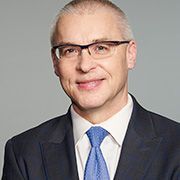Interview
Approaching Minnesota Health Care Through a New Lens
Jakub Tolar, MD, PhD, dean of the University of Minnesota Medical School
The University of Minnesota has recently launched the MPact 2025 strategic plan initiative, with a multi-pronged far-reaching agenda. What can you tell us about this?
MPact 2025 was inspired by the State of Minnesota and reflects the University’s deepened commitment to the core mission of research, teaching and service. It addresses access to opportunity and forward-thinking innovation that advances the University’s land-grant mission and impacts the world. Since this strategic plan’s inception, the University has set records for graduation rates, research funding, start-ups, patents, philanthropy and the number of Minnesota high school graduates enrolled as freshmen; and increased student career outcomes 10 percent over the national average. The University has been elevated into the top 25 among public universities and to number 2 in the United States for work related to promoting good health wellbeing.
In alignment with MPact 2025, the University’s plans for the future of University of Minnesota Health—announced earlier this year—include partnering with the State to reacquire key health care facilities on the Twin Cities campus, as well as committing to and planning for a new state-of-the-art hospital. This is all rooted in the discovery that has routinely positioned the University’s Medical Schools of Nursing, Dentistry and Public Health and Colleges of Pharmacy and Veterinary Medicine as among the world’s most innovative.
This vision aligns closely with the University’s commitment to develop and embrace new and leading health care delivery models, continues our focus as a leading health research university and ensures that we continue to produce both the next generation of health professionals, as well as med-tech and health science discoveries based on our research.
One element is the MPact Health Care Innovation Vision. What can you share about this?
The MPact Health Care Innovation Vision was created to advance health care around patient and community needs—striving for innovative treatments and cures and immediately using our research, education and public service experiences to bring the best care to bear for our patients. This intersection that is academic medicine is where our doctors and researchers excel.
The five points of this vision are: a world-class academic medical center integrating teaching and research with top-notch clinical care; University governance and control of key Twin Cities campus health care facilities to ensure the University’s public obligations are never compromised; a strong affiliation with partners throughout the state; planning for a state-of-the-art hospital with the concurrence and support of the Legislature; and addressing current facilities’ needs at the University Medical Center East and West Bank and Masonic Children’s Hospital.
But we cannot rest on our laurels. Dramatic changes in health care—leading up to, but especially following the pandemic—require a different approach. And one that is focused on accessibility to the best care across the entire State of Minnesota. For example, the University is working through hubs of health care, such as Duluth and St. Cloud, and investing in those areas by bringing academic medicine’s pursuit of innovative treatments together in collaboration with health care systems in every corner of our state.
A commitment to this vision means residents in Greater Minnesota will continue to feel the impact of our work. The University has affiliation agreements with nearly every health system operating in Minnesota. These collaborative health professional education relationships along with our Rural Physician Associate Program (RPAP), medical and pharmacy programs on the Duluth campus and expanding nursing and medicine relationships in St. Cloud with CentraCare will continue to serve Greater Minnesota.
Education and research are investments in the future of medicine.
Perhaps the most striking element of this vision is building a new $1 billion hospital on east campus. What can you tell us about these plans?
As part of the MPact Health Care Innovation vision, University Regents approved a request to the Minnesota Legislature for $950 million in 2023. Referred to as UMN Health, this request is the first phase of the MPact Health Care Innovation Vision plan: acquiring and operating the current health care facilities on the Twin Cities campus and launching their operations under the University’s leadership.
UMN Health seeks legislative support to reacquire key campus facilities—including the University Medical Center East and West Bank facilities, Masonic Children’s Hospital and the Clinics and Surgery Center—and cover operating costs for the projected transition period before clinical revenues again support operations.
This one-time investment would pay countless dividends and have a tremendously positive impact on Minnesotans and their health for generations. A building transfer that leaves Minnesota’s interests with a Fairview-Sanford centric merger, designed without University involvement, would undermine the future of Minnesota’s only public academic health system.
What does it entail when we hear about a new state-of-the art hospital?
The aging East and West Bank hospitals and facilities cannot provide the platform for a world-class academic health center for decades to come. Minnesota’s expectations for the next generation of treatments and cures, including well-trained health professionals cannot be met in facilities from the last century. A newly designed, state-of-the-art hospital is critical to the University’s mission and the long-term health of Minnesotans. This hospital may be designed to facilitate the transformative discovery that has routinely positioned the University of Minnesota health sciences schools and centers among the world’s most innovative. It will also serve Minnesota’s needs for health care delivery, education and innovation for the next century, advancing health and well-being as only a hospital associated with a leading research university can. Prior to a new state-of-the-art hospital, we will need to reacquire and update the current facilities to meet current community and research needs.
Why is University governance and control vital to this project?
It is essential that public assets—developed thanks to public support and investment and serving essential public needs—remain within Minnesota under University governance. Minnesotans see the benefits of having the U of M health professional schools and programs in their backyard every day because of the impact the University’s mission has on health care delivery at all levels. Minnesotans have access to leading edge care, and the reputation of our health professional schools and programs attracts world-class faculty and scientists to teach and train the next generation of health professionals for our state’s families and communities. That said, we know that health care is changing rapidly. Patients’ needs and expectations are evolving and this investment in Minnesota can position our state as a global leader in this changing environment.
The University’s valued partnership with the State has been critical to our shared success for the past 170 years, and it continues today. The reacquisition of the current facilities is tied to their ongoing charitable and public purpose of bringing forth accessible and state-of-the-art care to Minnesotans. These facilities are tied to public purpose and commitments of teaching, research and service and date back to the University’s founding in 1851. Treating these Minnesota assets as commercial fodder rather than recognizing their public value ignores their original purpose of serving the state.
Seven of the top 10 hospitals in the U.S. have university affiliations, why is this important?
We have learned that private health care nonprofits frequently see education and research as expenditures to cut. That conflicts with the public health mission of the University. We believe education and research are investments in the future of medicine and the health of a population.
Our focus is to ensure the best care for Minnesota patients and to deliver greater impacts to all Minnesotans through the University’s research, education and outreach mission. This model of care bridges the brightest minds from across the world to solve the most complex to most everyday health care challenges.
How will the new hospital enhance all of the world class research and care the University currently provides?
While not in our current request to the legislature, a new hospital in the future could focus on the patient experience and maximize the patient care impact from dedicated University clinicians. It could be designed to ensure an optimal education experience for future health care professionals and facilitate the clinical discovery needed to ensure leading-edge care delivery and innovation into the next century.
At this time, we are more focused on reacquiring current facilities from Fairview ownership. We must do that first so these public facilities are not placed at risk by a merger with Sanford Health.
What is the role the state legislature will play in bringing this project to light?
Our state officials and representatives have an important role. Our ongoing partnership with the State of Minnesota goes beyond one request—we have 135 years of supporting each other and holding each other accountable. Today, the University of Minnesota educates a majority of health care providers in Minnesota—from cancer care and nurses to public health professionals. The Medical School is the only public medical school in the state and teaches 70 percent of Minnesota’s physicians. The same is true for our College of Pharmacy and School of Dentistry—the only schools of their kind in Minnesota. The College of Pharmacy educates a majority of the state’s pharmacists—health professionals who provide critical roles in community and public health. Our School of Dentistry graduates 73 percent of the dentists practicing in Minnesota, as well as 68 percent of the licensed dental therapists. Additionally, the School of Nursing educates a majority of the nursing leaders and educators for the state, while the College of Veterinary Medicine provides critical collaborations in cancer research and understanding of diseases that move from animals to humans.
None of these health science schools could have succeeded without state support, and none of these practicing health professionals would be serving the state of Minnesota. The state partnership continues to be a lynchpin of success, and this project is no different.
What are some of the hurdles you expect the project to encounter?
The landscape is moving quickly. We are addressing the most timely hurdle as this piece publishes—negotiating the transfer of charitable assets back to the University from Fairview Health Services. We are proposing $950 million of support from the legislature; however, these negotiations will take place on the public stage with input from our state representatives.
How will this project will help leverage future strategic partnerships?
The University has agreements with nearly every health system operating in Minnesota—well beyond our M Health Fairview joint enterprise. We maintain clinical relationships in Duluth and Rochester, as well as extensive collaborations with Mayo Clinic on clinical trials and research. These relationships, plus our Rural Physician Associate Program, medical and pharmacy programs on the Duluth campus and currently-expanding nursing and medicine relationships in St. Cloud with CentraCare, will continue to serve Greater Minnesota. Minnesotans in every part of our state will benefit from the innovation planned from this initiative.
Jakub Tolar, MD, PhD, is dean of the Medical School and vice president for clinical affairs at the University of Minnesota.
MORE STORIES IN THIS ISSUE
cover story one
Mission Management: Connecting hospital trustees and physicians
By Daniel K. Zismer, PhD
cover story two
Generation Now Nursing: Redefining the value proposition















